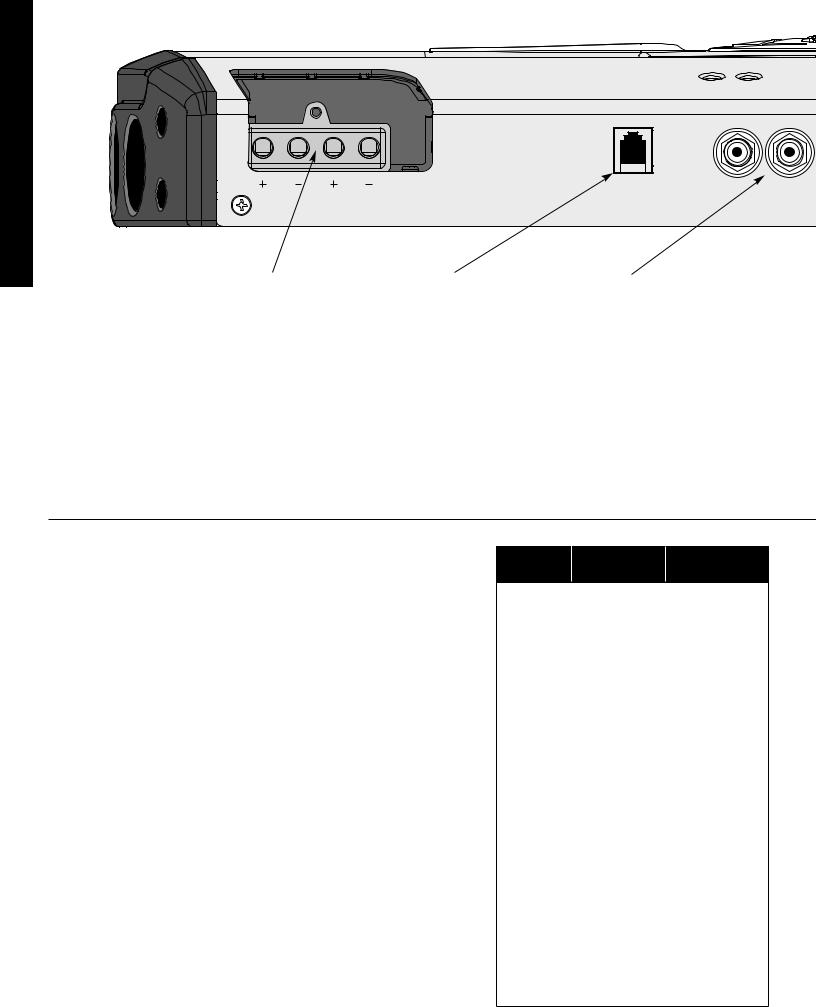Phoenix Gold Xenon Amplifier User Manual

www.phoenixgold.com
AMPLIFIER MANUALP

I N T R O D U C T I O N
Congratulations on purchasing one of the finest amplifiers available in the car audio marketplace today. The Xenon amplifiers were designed and engineered with the spirit of the original Phoenix Gold MS and M series to deliver bulletproof performance at any impedance while delivering unbelievable sound quality.
Co s m e t i c s :
Exotic sports cars were used for styling inspiration. The aluminum top is a custom tooled stamped, grained, and anodized case, the two intake vents are located on top of the case allow the variable speed cooling fan(s) to push cool air through the heatsink and exhaust out the side endcaps. The end caps are not removable and are made of a proprietary rubber, unlike any other amplifier on the market today. Using the same proprietary rubber, four large rubber grommets hide all mounting and terminal connections for the ultimate in stealth installation. The extruded heat sink resides inside the bottom of the amplifier. In the center of the amplifier is a 5mm ultra bright blue LED in a custom tooled headlight bezel which compliments the Xenon trademark.
Fu n c t i o n :
All of the Xe.Tune™ controls for the crossovers, sensitivity, and bass boost are located on the top of the amplifier. All crossovers are ultra precise LinkwitzRiley 24dB per octave and a separate high and low pass filter is available for each set of channels. This means that any standalone Xenon amplifier can be set to bandpass by turning both crossovers on. This feature is rarely available on any other amplifier on the market today. All crossover frequency potentiometers have 41 detents or “clicks”so the end user can set the exact crossover frequency desired. For example, turn the potentiometer 12 clicks for exactly 85Hz. No more turning the potentiometer and guessing where your crossover points are. Full Range Auxiliary Outputs, LPL and RMD Ports come standard on all units.
Large direct-insert 4 gauge power terminals and 12 gauge speaker terminals are also standard. On the X200.4 and X1200.1, there is a second set of power terminals located on the opposition side of the amplifier. This allows the installer to use dual 4 gauge inputs, or use the separate input for a power capacitor.
Power Output:
All Xenon amplifiers are rated according to the new CEA-2006 standard which is identical to how we have always rated all Phoenix Gold amplifiers. For example the X1200.1 will make a MINIMUM of 1200 watts with less than 1% THD @ 14.4 Volts from 1 to 4 ohm. Each Xenon amplifier comes with its own birth certificate that will meet or exceed our printed specifications.
Xenon amplifiers are designed to handle extreme abuse and drive almost any load. With Xe.Load™ technology its very easy to choose what speakers to wire to the amplifier to get maximum power from the amplifier. It doesn't matter whether its a DVC 2 ohm, SVC 4 ohm, or three DVC 1 ohm speakers. A Xenon amplifier automatically senses the load from 1 to 4 ohm and drives it with full power every time. This makes life simple for the end customer and guarantees he will always receive full power regardless of the load.
Circuit Topology:
The Xenon series two and four channel models use the legendary Triple Darlington output stage. This is same circuitry found in our MS, M, ZPA, ZX, and Titanium amplifiers. This topology is not cheap. This is why you rarely see any car amplifiers and only high end home amplifiers using this circuitry. This provides the ultimate in sound fidelity, headroom, reliability and can drive difficult loads without problems. The Triple Darlington output stage has three levels of amplification that ramp up the energy to the speaker load. The first sub-stage is the pre-drivers, which get their signal from the voltage gain stage and increase the available current in it or "stiffen" the signal. This stiffened signal is then fed to the driver transistors where it is stiffened even more. Finally, the output of the driver transistors is fed into the output transistors where it is stiffened substantially; enough to drive the speaker load wired to the amplifier.
All monoblocks are Class D technology. One clear advantage is that Class D amplifiers are much more efficient and this allows us to make a lot more power with a lower operating temperature and ease the strain on customer's electrical system. Of course, Class D amplifiers are low pass only, but 99% of monoblocks will be used on subwoofers. The average efficiency of a Xenon Monoblock is 80% from input to output, which means only 20% of the amplifier’s energy is turned into heat.
Cooling System:
We have completely reengineered the way amplifiers are thermally monitored with our Xe.Flow™ technology. First, we've added nearly 5 times the mass of heat sink relative to our very successful TCCH system used in the Titanium amplifiers. We also have bolted the transistors to the major heatsink, with minor extruded heatsink clamp down bars. This allows the transistor to have a heatsink on both sides of the device. Additionally, every model has a variable speed fan (except X400.1) located in the center of the amplifier for even more thermal dissipation. The combination of improved mass and the ability to move hot air out of the amplifier make it nearly impossible for them to engage their thermal protection.
Our competitor's amplifiers use a basic thermal protection that simply shuts the amplifier off when the heatsink reaches 90 degrees C. With the Xe.Flow technology the temperature of the amplifier is constantly monitored and its operation is optimized according to the temperature of the amplifier. For example, in the VERY RARE case that a Xenon amplifier begins to reach an unsafe temperature, the amplifier slowly reoptimizes the output of the amplifier. This adjustment in volume is very slight and the end user will most likely never hear it (less than 2dB), this puts the amplifier in an operating range that allows the amplifier to continue to play. The amplifier will monitor its own temperature and adjust its power output, so it will continue to play even on those hot days in the trunk in Texas.
Reliability:
Phoenix Gold has always been know for delivering more than what the customer expects. The Xenon line is no different, we have nearly double the number of output devices relative to the Titanium series. For example, the ultra reliable Ti500.4 was a 500 watt amplifier that used 8 output devices. We've taken that a step further with the X100.4, a 400 watt amplifier, that uses 16 of output devices, and the monstrous X200.4 uses 24 devices! This coupled with an excessive amount of bussbars, low ESR capacitors, Xe.Load and Xe.Flow technology make these amplifiers impossible to shut down at almost any load.
Sound Quality:
During the electrical design process, some of the finest parts were chosen to achieve the finest sound quality customers expect from a Phoenix Gold amplifier. Multiple small capacitors are located throughout the PCB layout. By using multiple smaller capacitors in parallel, this lowers the effective ESR of the circuit, (This is the same concept as if you were to parallel multiple subwoofers to achieve a lower impedance.) Since multiple small caps will have a lower ESR this will make them able to deliver energy much quicker than a few large caps. The end result is tighter, more accurate, and dynamic bass. The output stage on the two and four channel models are loaded with audiophile 150 Volt 15 amp Sanken output transistors. Sanken output transistors are used due to their high level of specification and amazing bandwidth of 60MHz. Each model of the amplifier design is critically listened to and evaluated by Phoenix Gold Engineering and Product staff for hours to ensure the sound quality is as close as possible to our in house master reference audio system.
Thank you again for purchasing Phoenix Gold product. We appreciate your business and desire to own the finest audio products.
2

Continuous Output Power: (Wattage Rated according to CEA 2006 Specifications of 14.4VDC and no more than 1%THD)
MONOBLOCK SPECIFICATIONS
Frequency Response: . . . . . . . . . . . |
. . .± 1dB from 20Hz to 300Hz |
X400.1 |
|
|
Signal to Noise Ratio: |
>90dB |
Into 4, 2 and 1 ohm . . . . . . . . . |
.400 x 1 |
|
Recommended Fuse Size: |
40A |
|||
|
|
|||
Subsonic and Low Pass Crossovers: |
Linkwitz-Riley 24dB per octave |
Power/Ground Wire Size . . . . . . |
8 Gauge |
|
Dimensions: . . . . .14L x 10.6W x 2.5H |
||||
Low Pass Crossover Range: |
30Hz to 300Hz |
|||
|
|
|||
Subsonic Crossover Range: . . . . . . . . . . . . . . . . . . . . . 5Hz to 55Hz
Bass Boost: . . . . . . . . . . . . . . . . . . . . . . . . . . . . . +18 dB @ 45 Hz
Input Sensitivity: . . . . . . . . . . . . . . . . . . . .200 millivolts to 8 volts
Lowest Recommend Load: . . . . . . . . . . . . . . . . . . . . . . . . . .1 ohm
X600.1
Into 4, 2 and 1 ohm . . . . . . . . . .600 x 1 Recommended Fuse Size: . . . . . . . .60A Power/Ground Wire Size . . . . . .4 Gauge Dimensions: . . .18.25L x 10.6W x 2.5H
X1200.1
Into 4, 2 and 1 ohm . . . . . . . . .1200 x 1 Recommended Fuse Size: . . . . . . .100A Power/Ground Wire Size . . . . . .4 Gauge Dimensions: . . . . .22L x 10.6W x 2.5H
TWO & FOUR CHANNEL SPECIFICATIONS
Frequency Response: . . . . . . . . . . . . . .± 1dB from 20Hz to 20kHz
Signal to Noise Ratio: . . . . . . . . . . . . . . . . . . . . . . . . . . . . .>100dB
High and Low Pass Crossovers: . . .Linkwitz-Riley 24dB per octave
Crossover Range: . . . . . . . . . . . . . . . . . . . . . . . . . . .40Hz to 400Hz
Bass Boost: . . . . . . . . . . . . . . . . . . . . . . . . . . . . .+18 dB @ 45 Hz
Input Sensitivity: . . . . . . . . . . . . . . . . . . . . .200 millivolts to 8 volts
Lowest Recommend Load: . . . . . . .2 ohm bridged or 1 ohm stereo
Xe . flow™ – Efficient Cooling!
X100.2
Into 4, 2, and 1 ohm stereo . . . .100 x 2 Into 8, 4, and 2 ohm bridged . . .200 x 1 Recommended Fuse Size: . . . . . . . .40A Power/Ground Wire Size . . . . . .8 Gauge Dimensions: . . . . .14L x 10.6W x 2.5H
X200.2
Into 4, 2, and 1 ohm stereo . . . .200 x 2 Into 8, 4, and 2 ohm bridged . . .400 x 1 Recommended Fuse Size: . . . . . . . .60A Power/Ground Wire Size . . . . . .4 Gauge Dimensions: . . . .15.5L x 10.6W x 2.5H
X100.4
Into 4, 2 and 1 ohm stereo . . . .100 x 4 Into 8, 4 and 2 ohm bridged . . .200 x 2 Recommended Fuse Size: . . . . . . . .80A Power/Ground Wire Size . . . . . .4 Gauge Dimensions: . . .18.25L x 10.6W x 2.5H
X200.4
Into 4, 2 and 1 ohm stereo . . . .200 x 4 Into 8, 4 and 2 ohm bridged . . .400 x 2 Recommended Fuse Size: . . . . . . .120A Power/Ground Wire Size . . . . . .4 Gauge Dimensions: 22L x 10.6W x 2.5H
Combines traditional internal heat sink design with cold air induction via a temperature controlled variable speed fan. This provides forced cold air movement across the Xenon amplifier heatsink. In addition, a proprietary thermal feedback circuit continuously monitors the temperature of the amplifier and optimizes the amplifier’s operation to guarantee the amplifier will continue to play regardless of how hard the amplifier is driven.
Xe . load™ – Max Power for All Loads!
Plug-n-Play speaker sensing optimizes amplifier to deliver full power into any load between (4ohm -1ohm). Xe.load™ makes life easy by allowing the user to get full power regardless of the impedance of his woofer or full range speakers.
Xe . tune™ – Crossover Features!
Audiophile 24dB Linkwitz-Riley crossover controls provide state of the art slope control. The Xe.tune™ detented control system allows users to perfectly adjust crossover slope every time without errors or guess work. Every Xenon amplifier has a separately defeatable continuously variable high and low pass filter for maximum processing flexibility
Now that’s total control!
S P E C I F I C A T I O N S
3

M O N O B L O C K S
RMD |
L |
R |
|
|
INPUT |
Speaker Outputs |
|
RMD |
|
INPUTS |
|
|
|
|
|
Used to connect the amplifier |
|
Remote Voltage Display |
|
Connect preamp signal |
to speakers. The separate + |
|
Input Connect the optional |
|
cables from the head unit |
and – terminals are internally |
|
RMD Voltage Display to |
|
to these terminals. To max- |
wired in parallel. Minimum |
|
this jack. |
|
imize noise rejection, we |
speaker cable size is 12 |
|
|
|
recommend using Phoenix |
|
|
|
||
gauge. Lowest recommend |
|
|
|
Gold ARx.800, ARx.700, |
impedance is 1 ohm. |
|
|
|
ARx.600 or ARx.500 series |
|
|
|
|
twisted pair interconnects. |
|
|
|
|
|
|
|
|
|
|
|
SUBSONIC |
LOWPASS |
CLICKS |
5-55Hz |
30-300Hz |
|
|
|
1* |
<10 |
28 |
|
|
|
2 |
<10 |
28 |
3 |
<10 |
28 |
|
|
|
4 |
<10 |
28 |
5 |
<10 |
28 |
|
|
|
6 |
<10 |
29 |
7 |
<10 |
31 |
|
|
|
8 |
<10 |
33 |
9 |
10.5 |
36 |
|
|
|
10 |
11.8 |
40 |
11 |
13.0 |
45 |
|
|
|
12 |
14.7 |
50 |
13 |
16.9 |
57 |
|
|
|
14 |
20.8 |
68 |
15 |
25.0 |
81 |
|
|
|
16 |
27.0 |
93 |
17 |
28.8 |
100 |
|
|
|
18 |
30.0 |
105 |
19 |
31.0 |
111 |
|
|
|
20 |
32.2 |
116 |
21 |
33.4 |
122 |
|
|
|
|
SUBSONIC |
LOWPASS |
CLICKS |
5-55Hz |
30-300Hz |
22 |
|
129 |
34.8 |
||
|
|
|
23 |
36.0 |
136 |
24 |
37.2 |
143 |
|
|
|
25 |
39.5 |
153 |
26 |
41.0 |
165 |
|
|
|
27 |
42.8 |
175 |
28 |
45.0 |
189 |
|
|
|
29 |
46.5 |
204 |
30 |
52.5 |
226 |
|
|
|
31 |
53.8 |
248 |
32 |
54.5 |
259 |
|
|
|
33 |
54.8 |
268 |
34 |
55.0 |
274 |
|
|
|
35 |
55.3 |
281 |
36 |
55.8 |
289 |
|
|
|
37 |
56.0 |
296 |
38 |
56.4 |
304 |
|
|
|
39 |
56.9 |
310 |
40 |
57.0 |
312 |
|
|
|
41** |
57.0 |
313 |
*Full Counter-Clockwise **Full Clockwise
4 |
www.phoenixgold.com |
|
